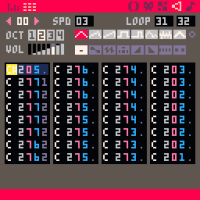PICO-8 does not really have a concept of tempo with regard to music, it has a concept of time.
One PICO-8 music tick is approximately 1/120th of a second.[1] At 60 frames per second, that's about two ticks per frame; at 30 frames per second, that's about four ticks per frame.
This shows up in an SFX two ways:
- The SPD of an SFX (a misleading name, gonna say that right upfront) is how many music ticks each line holds for. The default SPD is 16 - if you're thinking of each line as a sixteenth note in 4/4, that works out to about 112 BPM, which is a pretty normal allegro.
- The two arpeggio effects - effect 6 being the faster one and 7 the slower one - hold each of their notes for 4 ticks or 8 ticks, respectively.[2] (Which is to say: a blur of notes or a rapid sequence of notes, respectively.[3]) How exactly this works actually gets really messy if the SPD of the SFX is not a multiple of 16[5].
There is a kind of third way, which is: if you use a custom SFX instrument, that instrument will go through its ticks as long as its note is held. So, for example, a custom SFX instrument at SPD=1 that goes through all 32 lines of its SFX will take two lines of a SPD=16 SFX to finish playing. You can match this kind of thing to the music being created - we've created both staccato and grace notes for a SPD=24 piece by scheduling things within 24 ticks of a SPD=1 SFX, and we've taken a custom drum SFX and set it to loop exactly the right number of lines to do a double-stroke on that drum in a single line of a piece.
While the arpeggio effects (mostly[2]) aren't, a lot of the effects - 1=slide, 3=drop, 4=fade in, and 5=fade out - are based on the SPD of the line where the effect is played. The volume and pitch of the note in a slide will transition linearly from the previous note's at the beginning of the line to the destination note over the length of the line; the pitching-down of a note in a drop will be stretched out over the length of the line; the fade-in and fade-out will be linear between 0 and the given volume over the length of the line. If a slide or fade is too quick, it can be spread out between multiple slides; if it is too slow, there's ... not much you can do, other than make a custom SFX instrument.
But that's basically how it works. PICO-8 sounds are scheduled pitches of specific timbres over periods of time measured in music ticks.
[1] We suspect, but cannot prove, that it is actually 183/22 050 seconds - that is, 183 sample points at 22.05 kHz, the sampling frequency of an exported PICO-8 .wav file. This could be an artifact of exporting, however.
[2] If arpeggios are used in an effect with SPD 8 or less, these times are halved to 2 and 4 and the arps cycle twice as fast.
[3] An exception to this: if multiple lines have the same pitch - say, two lines at C2[4] and two lines at B2 - those notes will hold over and therefore sound slower and longer.
[4] PICO-8's C2 is C4 - middle C - in scientific pitch notation. Because reasons.
[5] There are grids, starting at the start of each SFX, for fast-arpeggios and slow-arpeggios within those SFX. Notes in the arpeggio during a line with an arpeggio effect will be picked based on what lines of that arpeggio's grid they fall on. ...you might just have to try it and see if it works.


